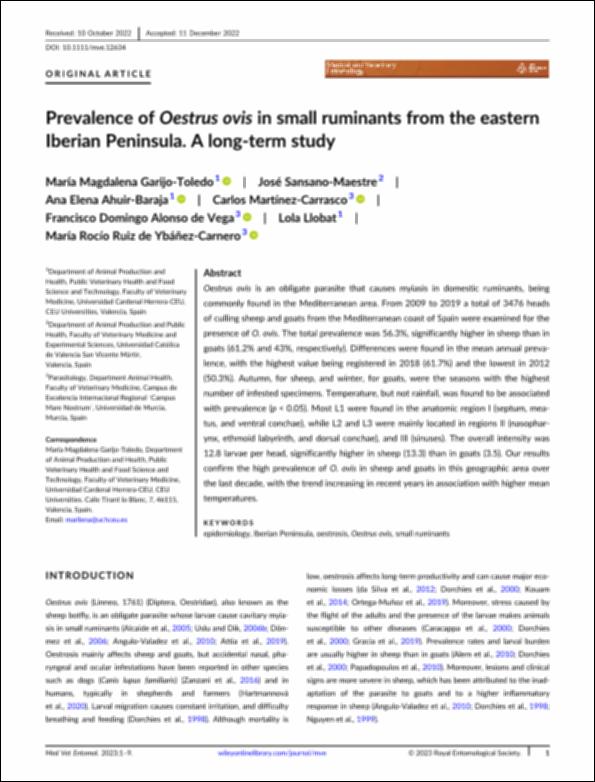Por favor, use este identificador para citar o enlazar este ítem:
http://hdl.handle.net/10637/14492Prevalence of "Oestrus ovis" in small ruminants from the eastern Iberian Peninsula a long-term study
| Título : | Prevalence of "Oestrus ovis" in small ruminants from the eastern Iberian Peninsula a long-term study |
| Autor : | Garijo Toledo, María Magdalena Sansano Maestre, José Ahuir Baraja, Ana Elena Martínez Carrasco, Carlos Alonso de Vega, Francisco Domingo Llobat Bordes, Lola Ruiz de Ybáñez, María Rocío |
| Materias: | Myiasis in goats.; Myiasis in sheep.; Goats - Parasites.; Sheep - Parasites.; Miasis en cabras.; Cabras - Parásitos.; Ovejas - Parásitos.; Miasis en ovejas. |
| Editorial : | John Wiley & Sons Royal Entomological Society |
| Citación : | Garijo-Toledo, M.M., Sansano-Maestre, J., Ahuir-Baraja, A.E., Martínez-Carrasco, C., de Vega, F.D.A., Llobat, L. & de Ybáñez-Carnero, M.R.R. (2023). Prevalence of Oestrus ovis in small ruminants from the eastern Iberian Peninsula : a long-term study. Medical and Veterinary Entomology, vol. 37, i. 2 (jun.), pp. 330–338. DOI: https://doi.org/10.1111/mve.12634 |
| Resumen : | Oestrus ovis is an obligate parasite that causes myiasis in domestic ruminants, being commonly found in the Mediterranean area. From 2009 to 2019 a total of 3476 heads of culling sheep and goats from the Mediterranean coast of Spain were examined for the presence of O. ovis. The total prevalence was 56.3%, significantly higher in sheep than in goats (61.2% and 43%, respectively). Differences were found in the mean annual prevalence, with the highest value being registered in 2018 (61.7%) and the lowest in 2012 (50.3%). Autumn, for sheep, and winter, for goats, were the seasons with the highest number of infested specimens. Temperature, but not rainfall, was found to be associated with prevalence (p < 0.05). Most L1 were found in the anatomic region I (septum, meatus, and ventral conchae), while L2 and L3 were mainly located in regions II (nasopharynx, ethmoid labyrinth, and dorsal conchae), and III (sinuses). The overall intensity was 12.8 larvae per head, significantly higher in sheep (13.3) than in goats (3.5). Our results confirm the high prevalence of O. ovis in sheep and goats in this geographic area over the last decade, with the trend increasing in recent years in association with higher mean temperatures. |
| Descripción : | Este artículo se encuentra disponible en la siguiente URL: https://resjournals.onlinelibrary.wiley.com/doi/epdf/10.1111/mve.12634 This is the peer reviewed version of the following article: Garijo-Toledo, M. M., Sansano-Maestre, J., Ahuir-Baraja, A. E., Martínez-Carrasco, C., de Vega, F. D. A., Llobat, L. & de Ybáñez-Carnero, M. R. R. (2023). Prevalence of "Oestrus ovis" in small ruminants from the eastern Iberian Peninsula : a long-term study. Medical and Veterinary Entomology, vol. 37, i. 2 (jun.), pp. 330?338, which has been published in final form at https://doi.org/10.1111/mve.12634. This article may be used for non-commercial purposes in accordance with Wiley Terms and Conditions for Use of Self-Archived Versions. This article may not be enhanced, enriched or otherwise transformed into a derivative work, without express permission from Wiley or by statutory rights under applicable legislation. Copyright notices must not be removed, obscured or modified. The article must be linked to Wiley?s version of record on Wiley Online Library and any embedding, framing or otherwise making available the article or pages thereof by third parties from platforms, services and websites other than Wiley Online Library must be prohibited. Este es el post-print del siguiente artículo: Garijo-Toledo, M. M., Sansano-Maestre, J., Ahuir-Baraja, A. E., Martínez-Carrasco, C., de Vega, F. D. A., Llobat, L. & de Ybáñez-Carnero, M. R. R. (2023). Prevalence of "Oestrus ovis" in small ruminants from the eastern Iberian Peninsula : a long-term study. Medical and Veterinary Entomology, vol. 37, i. 2 (jun.), pp. 330?338, que se ha publicado de forma definitiva en: https://doi.org/10.1111/mve.12634 Este artículo tiene embargado el acceso al texto completo hasta el 30-06-2024. |
| URI : | http://hdl.handle.net/10637/14492 |
| Derechos: | http://creativecommons.org/licenses/by-nc-nd/4.0/deed.es |
| ISSN : | 0269-283X 1365-2915 (Electrónico) |
| Idioma: | es |
| Fecha de publicación : | 4-jun-2023 |
| Centro : | Universidad Cardenal Herrera-CEU |
| Aparece en las colecciones: | Dpto. Producción y Sanidad Animal, Salud Pública Veterinaria y Ciencia y Tecnología de los Alimentos |
Los ítems de DSpace están protegidos por copyright, con todos los derechos reservados, a menos que se indique lo contrario.


